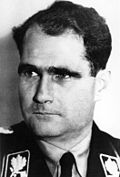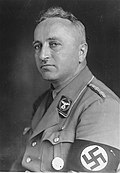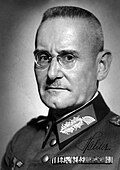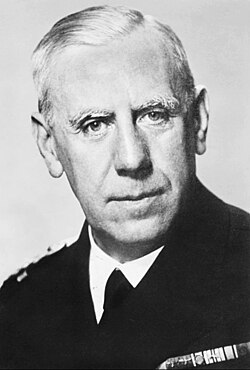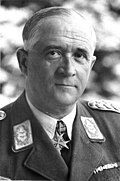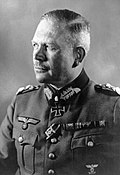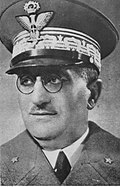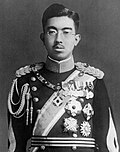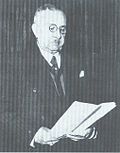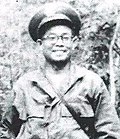Top Qs
Linha do tempo
Chat
Contexto
Líderes do Eixo na Segunda Guerra Mundial
Lista dos Líderes políticos e militares das Potências do Eixo durante a Segunda Guerra Mundial Da Wikipédia, a enciclopédia livre
Remove ads
Os Líderes das Potências do Eixo da Segunda Guerra Mundial foram importantes figuras políticas e militares durante a Segunda Guerra Mundial. O Eixo foi estabelecido com a assinatura do Pacto Tripartite em 1940 e perseguia uma ideologia fortemente militarista e nacionalista; com uma política de anticomunismo. Durante a fase inicial da guerra, governos fantoches foram estabelecidos nas nações ocupadas. Quando a guerra terminou, muitos deles foram julgados por crimes de guerra. Os principais líderes foram Adolf Hitler da Alemanha Nazista, Benito Mussolini da Itália Fascista e Hirohito do Japão Imperial. [1] [2] Ao contrário do que aconteceu com os Aliados, nunca houve uma reunião conjunta dos principais chefes de governo do Eixo, embora Mussolini e Hitler se reunissem regularmente.
Remove ads
Reino da Bulgária (1941–1944)
Remove ads
Alemanha Nazista
Resumir
Perspectiva
Remove ads
Reino da Hungria (1940–1945)
Reino da Itália (1940–1943) e República Social Italiana (1943–1945)
Resumir
Perspectiva
Remove ads
Império do Japão
Resumir
Perspectiva
Remove ads
Reino da Romênia (1940–1944)
Remove ads
Estados Clientes e Protetorados do Eixo
República Eslovaca (1939–1945)
Estado Francês (1940-1944)
Estado Independente da Croácia (1941-1945)
Remove ads
Estados Fantoches da Alemanha Nazista
Resumir
Perspectiva
Protetorado da Dinamarca (1940-1945)
Província de Liubliana (1943–1945)
Governo Nacional Norueguês (1940-1945)
Governo de Salvação Nacional da Sérvia (1941–1944)
Remove ads
Estados Fantoches do Reino da Itália
Resumir
Perspectiva
Reino da Albânia (1940–1943)
Reino de Montenegro (1941–1943)
Estados Fantoches Germano-Italianos
Estado Helênico (1941-1944)
Remove ads
Estados Fantoches do Império do Japão
Resumir
Perspectiva
Estado da Birmânia (1942–1945)
Reino do Kampuchea (1945)
Governo Nacional Reorganizado da República da China (1940–1945)
Governo Provisório da Índia Livre (1943–1945)
Reino do Laos (1945)
Império da Grande Manchúria
Governo Autônomo Unido de Mengjiang
Segunda República das Filipinas (1943-1945)
Império do Vietnã (1945)
Remove ads
Estados Combatentes Co-beligerantes
Resumir
Perspectiva
Vários países lutaram lado a lado com as potências do Eixo por uma causa comum. Estes países não eram signatários do Pacto Tripartite e, portanto, não eram membros formais do Eixo.
Finlândia (1941–1944)
Reino do Iraque (1941)
Reino da Tailândia (1942–1945)
Referências
- Ferro, Marc (15 fev 2007). Ils étaient sept hommes en guerre. [S.l.]: Robert Laffont Group. ISBN 978-2221100943
- Burleigh, Michael (1 jan 2010). Moral Combat: A History of World War II. [S.l.]: Harper. ISBN 978-0007195763
- Tsar's Coup Time, 4 February 1935. retrieved 10 August 2008.
- L'ABOURDETTE, Jean-Paul; PANAYOTOVA, Nevena; AUZIAS, Dominique (2008). Bulgarie (em francês). [S.l.]: Petit Futé. p. 54-55. ISBN 978-2-7469-2141-2
- Geoffrey Hindley, The Royal Families of Europe, p. 156. London: Lyric Books Ltd., 1979. ISBN 0-07-093530-0
- ''Bulgaria in the Second World War'' by Marshall Lee Miller, Stanford University Press, 1975.
- Frederick B. Chary, The History of Bulgaria, ABC-CLIO, 2011, p. 116
- Bendersky, Joseph W (2000). A History of Nazi Germany: 1919–1945. Lanham: Rowman & Littlefield. ISBN 978-1-4422-1003-5.
- Bullock, Alan (1962) [1952]. Hitler: A Study in Tyranny. London: Penguin Books. ISBN 978-0-14-013564-0.
- Evans, Richard J. (2005). The Third Reich in Power. New York: Penguin. ISBN 978-0-14-303790-3.
- Manvell, Roger (2011) [1962]. Goering. London: Skyhorse. ISBN 978-1-61608-109-6.
- Overy, Richard J. (1984). Goering: The Iron Man. [S.l.]: Routledge.
- Breitman, Richard (2004). Himmler and the Final Solution: The Architect of Genocide. London: Pimlico. ISBN 978-1-84413-089-4.
- Longerich, Peter (2012). Heinrich Himmler: A Life. Oxford; New York: Oxford University Press. ISBN 978-0-19-959232-6.
- Bloch, Michael. Ribbentrop. New York: Crown Publishing, 1992. ISBN 0-517-59310-6.
- Grier, Howard D. (2007). Hitler/Dönitz and the Baltic Sea - The Third Reich´s Last Hope, 1944-1945 (Cap. 10: Hitler and Dönitz). [S.l.]: Naval Institute Press
- Klee, Ernst (2005). Das Personenlexikon zum Dritten Reich. Wer war was vor und nach 1945 (Zweite Auflage ed.). Frankfurt am Main: Fischer Taschenbuch Verlag. p. 574. ISBN 978-3-596-16048-8.
- Hamilton, Charles (1984). Leaders & Personalities of the Third Reich, Vol. 1. San Jose, CA: R. James Bender Publishing. ISBN 0-912138-27-3.
- Chesler, Caren (1 October 2014). "Rudolf Hess' Tale of Poison, Paranoia and Tragedy". Smithsonian Magazine. Smithsonian Institution.
- Jackson, Robert (July 26, 1946). "Summation of Robert Jackson in the Nuremberg Major War Figures Trial".
- Fest, Joachim (2007). Albert Speer: Conversations with Hitler's Architect (em inglês). [S.l.]: Polity Press. ISBN 0-7618-0872-8.
- Bollmus, Reinhard (1970). Das Amt Rosenberg und seine Gegner: Studien zum Machtkampf im Nationalsozialistichen Herrschaftssystem. Stuttgart: Deutsche Verlags-Anstalt.
- Calic, Edouard (1985) [1982]. Reinhard Heydrich: The Chilling Story of the Man Who Masterminded the Nazi Death Camps. New York: Morrow. ISBN 978-0-688-00481-1.
- Snyder, Louis L (1976). Encyclopedia of the Third Reich. London: Robert Hale. ISBN 978-1-56924-917-8.
- Koll, Johannes: Arthur Seyß-Inquart und die deutsche Besatzungspolitik in den Niederlanden (1940–1945). Böhlau, Wien [u. a.] 2015, ISBN 978-3-205-79660-2.
- Dieter A. Binder: Seyss-Inquart Arthur. In: Österreichisches Biographisches Lexikon 1815–1950 (ÖBL). Volume 12, Academia Austríaca de Ciências, Viena 2001−2005, ISBN 3-7001-3580-7, S. 213 f.
- Goerlitz, Walter (2003). "Keitel, Jodl, and Warlimont". In Barnett, Correlli (ed.). Hitler's Generals. Grove Press. pp. 139–175. ISBN 978-0802139948.
- «Franz Halder» (em alemão). Lexikon der Wehrmacht. Consultado em 10 de janeiro de 2014
- Hitler's Spy Chief: The Wilhelm Canaris Mystery, by Richard Bassett, 2005, Cassell.
- Gerbet, Klaus and Johnston, David. Generalfeldmarschall Fedor von Bock: The War Diary 1939–1945. Schiffer Publishing. 1 January 2000
- Forczyk, Robert (2010). Manstein: Leadership – Strategy –Conflict. Oxford: Osprey. ISBN 978-1-84603-221-9.
- Battistelli, Pier (2011). Heinz Guderian: Leadership, Strategy, Conflict. United Kingdom: Osprey Publishing Ltd. ISBN 978-1-84908-366-9
- Bierman, John; Smith, Colin (2004). War Without Hate: The Desert Campaign of 1940–43. [S.l.]: Penguin Books. ISBN 978-0142003947.
- Bradley, Dermot [in German] (1994), "Model, Walter", Neue Deutsche Biographie (in German), vol. 17, Berlin: Duncker & Humblot, pp. 597–598
- «1920: Termina monarquia húngara». Consultado em 20 de Maio de 2016
- Stenge, Csaba; Olasz, Lajos; Maráczi, Tamás (15 de setembro de 2012), Horthy István halála, 1942. augusztus 20. Hír TV Ősök Tere, 2012 (in Hungarian).
- Frucht 2000, p. 56.
- Botond, Clementis-Záhony (1988). "Bárdossy Reconsidered: Hungary's Entrance into World War II". Triumph in Adversity. New York.
- C A Macartney, October Fifteenth: A History of Modern Hungary, 1929–1945, 2 vols, Edinburgh University Press 1956–7.
- Thomas L. Sakmyster: A Hungarian Diplomat in Nazi Berlin: Sztójay Döme. In: Hungarian history – world history, szerkesztette Ránki György. Budapest: Akadémiai Kiadó, 1984.
- Cohen, Asher. "Some Socio-Political Aspects of the Arrow Cross Party in Hungary." East European Quarterly 21.3 (1987): 369+
- Kenez, Peter. Hungary from the Nazis to the Soviets: the Establishment of the Communist Regime in Hungary, 1944-1948 (Cambridge University Press, 2006).
- MAK SIMTH, Denis (1989). Italy and Its Monarchy. New Haven: Yale University Press. p. 267
- MONTANELLI, Indro (1979). Storia d'Italia. [S.l.: s.n.]
- Brenda Haugen (2007). Benito Mussolini: Fascist Italian Dictator. Mankato: Compass Point Books. ISBN 978-0-7565-1988-9
- Stewart 2009, p. 246
- BALBO, Italo (2005). La centuria alata. Montepulciano: Editrice Le Balze. 308 páginas. ISBN 88-7539-059-2
- The Ciano Diaries 1939-1943: The Complete, Unabridged Diaries of Count Galeazzo Ciano, Italian Minister of Foreign Affairs, 1936-1943, 2000, ISBN 1-931313-74-1
- "Rodolfo Graziani, marquess di Neghelli — Italian military officer". Página acessada em 6 de setembro de 2021.
- Schlemmer, Thomas (2008). «Giovanni Messe: Ein italienischer General zwischen Koalitions- und Befreiungskrieg». Von Feldherren und Gefreiten (em alemão). [S.l.: s.n.] pp. 33–44. ISBN 9783486581447. OCLC 191658382. doi:10.1524/9783486708264.33
- Focardi, Filippo (2016). «Roatta, Mario» (em italiano). Dizionario Biografico degli Italiani. Consultado em 24 Jun 2022
- Daniel Barenblat, A plague upon humanity, 2004, p.37.
- Yoshiaki Yoshimi, Dokugasusen Kankei Shiryō II, Kaisetsu(Materials on Poison Gas Warfare), 1997, pp.25–29., Herbert P. Bix, Hirohito and the Making of Modern Japan, 2001
- Berger, Gordon M. (1974). "Japan's Young Prince. Konoe Fumimaro's Early Political Career, 1916–1931". Monumenta Nipponica. 29 (4): 451–475. doi:10.2307/2383896. ISSN 0027-0741. JSTOR 2383896.
- Sherman, Christine. War Crimes: International Military Tribunal. Turner Publishing Company. (2001). ISBN 1-56311-728-2.
- Bix, Herbert P. (2001). Hirohito and the Making of Modern Japan. Harper Perennial. ISBN 0-06-093130-2.
- Amerasia; a Review of America and the Far East (em inglês). [S.l.: s.n.] 1944. p. 240
- THURMAN, Malcolm J., THURMAN, Christine S. War crimes: Japan's World War II atrocities. Turner Publishing Company. Paducah, 2001. p. 231.
- Tolischus, Otto David (1946). Through Japanese Eyes (em inglês). Washington D.C.: Infantry Journal. p. 185
- Maga, Timothy P. (2001). Judgment at Tokyo: The Japanese War Crimes Trials. [S.l.]: University Press of Kentucky. ISBN 0-8131-2177-9
- Yuki Tanaka, Poison Gas, the Story Japan Would Like to Forget, Bulletin of the Atomic Scientists, October 1988, p. 16-17.
- Ammenthorp, Steen (2000). "Terauchi, Hisaichi". The Generals of World War II
- Piccigallo, Philip R (1980). The Japanese on Trial: Allied War Crimes Operations in the East, 1945–1951. University of Texas Press. ISBN 0-292-78033-8.
- Butow, Robert J. C. (1954). Japan's Decision to Surrender. Stanford University Press. ASIN: B000VFCC14.
- Spector, Ronald (1985). Eagle Against the Sun: The American War With Japan. Vintage. ISBN 0-394-74101-3.
- Bradley, F.J. (2014). He Gave the Order: The Life and Times of Admiral Osami Nagano. Bennington, VT: Merriam Press. ISBN 9781576383711.
- Glines, Carroll V. Attack on Yamamoto (1st edition). New York: Crown, 1990. ISBN 978-0-517-57728-8.
- «CEI OPT MAREŞALI AI ROMÂNIEI (ISBN 978-606-8371-95-5)» (em inglês). Consultado em 17 de março de 2023
- Friedman, Jonathan C. (2010). The Routledge History of the Holocaust (em inglês). Abindgdon-on-Thames: Taylor & Francis. p. 278
- Ward, James Mace; (2013); Priest, Politician, Collaborator: Jozef Tiso and the Making of Fascist Slovakia. Cap.1 e 2; Ithaca and London; Cornell University Press. ISBN 978-0-8014-4988-8
- Dwork (2003) pp, 168–169
- Dank, Milton. The French Against the French: Collaboration and Resistance, p. 361.
- Paxton, Robert O. (1982). Vichy France: Old Guard and New Order, 1940–1944, pp. 36–37. Columbia University Press. ISBN 0-231-12469-4.
- Fred Kupferman, Le Procès de Vichy : Pucheu, Pétain, Laval, Éditions Complexe, 2006 (frz.)
- Maurice Rajsfus, La Police de Vichy. Les Forces de l'ordre françaises au service de la Gestapo, 1940/1944, Le Cherche Midi éditeur, 1995. Chapter XIV, "La Bataille de Marseille", pp. 209–217 (em francês)
- «Joseph Darnand». worldatwar.net (em inglês). Consultado em 27 de agosto de 2012
- On the WWII Nazi Croatia, see [S. Trifkovic, Ustaša: Croatian Fascism and European Politics, 1929−1945, The Lord Byron Foundation, 2011; R. McCormick, Croatia under Ante Pavelic: America, The Ustaše and Croatian Genocide, London−New York, I.B.Tauris & Co Ltd, 2014].
- Yugoslavia, Holocaust Encyclopedia, United States Holocaust Memorial Museum
- Serbia's secret war: propaganda and the deceit of history; p 94
- Rodogno, Davide; Fascism's European empire: Italian occupation during the Second World War; p.95; Cambridge University Press, 2006 ISBN 0-521-84515-7 "Devoid of political experience and ignorant of the Italian government's exact intentions, he [the Duke Aimone] refused to leave for Croatia, saying so in letters to Victor Emmanuel and Mussolini, in which he told them that the question of Dalmatia, 'a land that could never be Italianized', was an obstacle against any reconciliation with the Croats. Never, he declared, would he agree to be a king of a nation amputated from Italy." .
- Massock, Richard G.; Italy from Within; p.306; READ BOOKS, 2007 ISBN 1-4067-2097-6
- Burgwyn, H. James; Empire on the Adriatic: Mussolini's conquest of Yugoslavia 1941-1943; p.39; Enigma, 2005 ISBN 1-929631-35-9
- Royal Institute of International Affairs; Enemy Countries, Axis-Controlled Europe; Kraus International Publications, 1945 ISBN 3-601-00016-4
- Rezun, Miron (30 de maio de 1995). Europe and war in the Balkans: toward a new Yugoslav identity. [S.l.]: Greenwood Press. p. 62. ISBN 027595238X.
The duke agreed to accept the throne and became King Tomislav II of Croatia
- Friedman, Francine (22 de janeiro de 2004). Bosnia and Herzegovina: a polity on the brink. [S.l.]: Routledge. p. 130. ISBN 0415274354.
...nominally Croatia was ruled by the Italian Duke of Spoleto styled as King Tomislav II...
- Dedijer, Vladimir (1979). History of Yugoslavia. [S.l.: s.n.] p. 573.
...The new king was given the title of Tomislav II...
- Romano, Sergio (1 de março de 1999). An outline of European history from 1789 to 1989. [S.l.]: Berghahn Books. p. 130. ISBN 1571810765.
...the Duke of Spoleto, became king, with the name of Tomislav II...
- Salmaggi, Cesare; Pallavisini, Alfredo (1 de maio de 1984). 2194 days of war. [S.l.]: E Mayflower Books. p. 149. ISBN 0831789417.
...Croatia is constituted an independent nation under Tomislav II...
- Lemkin, Raphael; Power, Samantha (2005). Axis Rule In Occupied Europe: Laws Of Occupation, Analysis Of Government, Proposals For Redress. [S.l.]: Lawbook Exchange. p. 253. ISBN 1584775769
- «Foreign News: Hotel Balkania». Time Magazine. 9 de agosto de 1943. Consultado em 4 de dezembro de 2009
- Dizdar et al. 1997, p. 253.
- Kujundžić, Milivoj (1995). Doprinos hrvatske pobjedi antifašističke koalicije (em croata). [S.l.]: Odbor za obilježavanje 50. obljetnice pobjede antifašističke koalicije u Europi i svijetu sabora Republike Hrvatske
- "Tko je tko u NDH", Minerva, Zagreb, 1997; ISBN 953-6377-03-9, str. 226–227.(em croata)
- «Vojne jedinice, ustanove i organizacije» (em croata). Croatian State Archives. Cópia arquivada em 1 de fevereiro de 2009
- Neulen, H. W. (2000). In the Skies of Europe: Air Forces Allied to the Luftwaffe, 1939–1945. Wiltshire, England: Crowood Press. ISBN 978-1-86126-326-1
- Pojić, Milan (1997). «Angeli, Edgar». In: Dizdar, Zdravko; Grčić, Marko; Ravlić, Slaven; Stuparić, Darko. Tko je tko u NDH (em croata). Zagreb, Croatia: Minerva. p. 9. ISBN 978-953-6377-03-9
- Dizdar, Zdravko (1997). "Luburić, Vjekoslav". In Dizdar, Zdravko; Grčić, Marko; Ravlić, Slaven; Stuparić, Darko (eds.). Tko je tko u NDH (in Croatian). Zagreb, Croatia: Minerva. pp. 240–242. ISBN 978-953-6377-03-9
- «General der Artillerie Leonhard Kaupisch - Lexikon der Wehrmacht». www.lexikon-der-wehrmacht.de. Consultado em 18 de julho de 2016
- Kirchhoff, Hans; Lauridsen, John T.; Trommer, Aage, eds. (2002). Gads leksikon om dansk besættelsestid, 1940–1945 [Gads Encyclopedia of Danish Occupation, 1940–1945]. Copenhagen: Gads Forlags
- «Kampen om Scavenius' eftermæle». Berlingske.dk (em dinamarquês). 8 de novembro de 2003. Consultado em 9 de julho de 2021
- Lidegaard, Bo (2011). En fortælling om Danmark i det 20. Århundrede (em dinamarquês). Copenhagen: Gyldendal
- Ole Ravn, Fører uden folk : Frits Clausen og Danmarks National Socialistiske Arbejder-Parti, University of Southern Denmark, 2007. ISBN 978-87-7674-203-4
- Boris Mlakar, Slovensko domobranstvo (Ljubljana: Slovenska matica, 2003)
- «Supreme Court Repeals Conviction of Bishop Rožman». Slovenia Times. 11 Out 2007. Consultado em 23 Jan 2016. Cópia arquivada em 16 maio 2011
- Ministries 1940 – 1945. Under German occupation in Oslo — Government.no
- Time Magazine: The Bishop and the Quisling, Monday, 25 December 1944
- Norgeslexi.com: Nasjonal Samling's youth and children efforts Arquivado em 2012-03-01 no Wayback Machine (em norueguês)
- NorgesLexi.com: Skancke, Ragnar (Sigvald) (1890—1948) Arquivado em 2011-05-25 no Wayback Machine (em norueguês)
- Vigness, Paul G. (1970). The German Occupation of Norway. [S.l.]: Vantage Press, New York. ISBN
- Arneberg, Sven T. (1989). Vi dro mot nord : felttoget i Norge i april 1940, skildret av tyske soldater og offiserer: (Oslo, Østfold, Akershus, Hedmark, Oppland, Møre og Romsdal) (em norueguês). [S.l.]: Aventura. p. 254
- Guhnfeldt, Cato (5 de fevereiro de 2005). «Skuddene som kostet 28 livet». Aftenposten (em norueguês). Oslo. Consultado em 30 de junho de 2008. Cópia arquivada em 9 de fevereiro de 2005
- Hitlerin Saksa ja sen vapaaehtoisliikkeet, p. 121, Mauno Jokipii, 2002, Suomalaisen Kirjallisuuden Seura ISBN 951-746-335-9
- Roberts, Walter R. (1973). Tito, Mihailovic, and the Allies, 1941-1945 (em inglês). [S.l.]: Rutgers University Press. 406 páginas. ISBN 9780813507408
- Tomasevich, Jozo (2001). War and Revolution in Yugoslavia, 1941–1945: Occupation and Collaboration. Stanford, California: Stanford University Press. ISBN 978-0-8047-3615-2
- Cohen 1996, p. 14.
- Ramet 2006, p. 101.
- Tomasevich, Jozo (2001). War and Revolution in Yugoslavia, 1941–1945: Occupation and Collaboration. Stanford, California: Stanford University Press. ISBN 978-0-8047-3615-2
- Fischer, Bernd Jürgen; Fischer, Fischer, Bernd Jürgen (1999). Albania at War, 1939–1945 (em inglês). [S.l.]: Purdue University Press. ISBN 978-1-55753-141-4
- Lulushi, Albert (3 de junho de 2014). Operation Valuable Fiend: The CIA's First Paramilitary Strike Against the Iron Curtain (em inglês). [S.l.]: Skyhorse Publishing, Inc. ISBN 978-1-62872-394-6
- Pavlović, Vojislav G. (1 de janeiro de 2014). Italy's Balkan Strategies (19th–20th Century) (em inglês). [S.l.]: Balkanološki institut SANU. ISBN 978-86-7179-082-6
- Pearson, Owen. Albania and King Zog: Independence, Republic and Monarchy 1908-1939. Albania in the twentieth century, v. 1. London: Centre for Albanian Studies in association with IB Tauris Publishers, 2004. p. 458
- Roberts 2007, p. 353.
- Пајовић 1977, pp. 203.
- Schmider 2002, p. 369.
- «Γεώργιος Τσολάκογλου» George Tsolakoglou. San Simera (em grego). Consultado em 16 de maio de 2021
- Markos Vallianatos, The untold history of Greek collaboration with Nazi Germany (1941-1944). [S.l.]: Pelekys Books. 2014. 210 páginas
- «Ιωάννης Ράλλης». San Simera (em grego). Consultado em 16 de maio de 2021
- Riches, Christopher (2013). A Dictionary of Political Biography. [S.l.]: Oxford University Press
- Ferguson, John (1981). Essays on Burma. [S.l.]: Brill Archive
- Jeldres, Julio A., 2003, The Royal House of Cambodia, Monument Books, Phnom Penh
- Jagel, Matthew (2023). Khmer Nationalist: Sơn Ngc Thành, the CIA, and the Transformation of Cambodia. [S.l.]: Cornell University Press
- Narangoa, Li; Cribb, R.B. (2003). Imperial Japan and national identities in Asia, 1895-1945. [S.l.]: Routledge. p. 13. ISBN 0700714820
- David P. Barrett and Larry N. Shyu, eds.; Chinese Collaboration with Japan, 1932-1945: The Limits of Accommodation Stanford University Press 2001
- «Subhash Chandra Bose». Consultado em 16 Fev 2006. Arquivado do original em 14 Jan 2006
- Pasricha, Ashu (2008). "The Political Thought of Subhas Chandra Bose". Encyclopaedia Eminent Thinkers, 16, Concept Publishing Company.
- «KING OF LAOS DIES IN PALACE' AT 74; Ruler in Southeast Asi, Since 1905 Was Known as World's Senior Monarch». The New York Times (em inglês). 30 de outubro de 1959. ISSN 0362-4331. Consultado em 14 de outubro de 2023
- «Manchukuo | puppet state created by Japan in China [1932]». Encyclopedia Britannica (em inglês)
- «CHINA: Noble End of Chang Ching-hui». TIME. 4 jan 1943. Consultado em 22 maio 2011. Cópia arquivada em 27 jan 2008
- Jowett, Phillip J., Rays of the Rising Sun Vol 1., Helion & Co. Ltd. 2004.
- Wang (2008), p. 97
- Liu (2004), p. 132
- Jowett, Phillip S., '''Rays of The Rising Sun, Armed Forces of Japan's Asian Allies 1931–45, Volume I: China & Manchuria,''' 2004. Helion & Co. Ltd., England.
- «José Paciano Laurel». Encyclopædia Britannica. Arquivado do original em 7 de maio de 2014
- Stanley Karnow, Vietnam: A History p162 "Nothing has reinforced the Vietminh cause more than the mercurial Bao Dai's decision to abdicate. For his gesture conferred the 'mandate of heaven' on Ho, giving him the legitimacy that, in Vietnamese eyes, had traditionally resided in the emperor."
- «Ngày 9-3-1945: Phát xít Nhật đảo chính thực dân Pháp trên toàn cõi Đông Dương». https://www.qdnd.vn (em inglês). Consultado em 14 de outubro de 2023
- «Gustaf Mannerheim». Vad varje svensk bör veta (em sueco). Estocolmo: Thomas Magnusson e Peter A. Sjögren; Albert Bonniers Förlag e Publisher Produktion AB. 2004. p. 37. 654 páginas. ISBN 91-0-010680-1
- Jussila, Osmo; Hentilä, Seppo; Nevakivi, Jukka (1999). From Grand Duchy to a Modern State: A Political History of Finland Since 1809 (em inglês). Londres: Hurst & Company. p. 361
- Jussila, Osmo; Hentilä, Seppo; Nevakivi, Jukka (1999). From Grand Duchy to a Modern State: A Political History of Finland Since 1809 (em inglês). Londres: Hurst & Company. p. 361
- Magnusson, Thomas; Sjögren, Peter A. (2004). «Fortsättningskriget». Vad varje svensk bör veta (em sueco). Estocolmo: Albert Bonniers Förlag e Publisher Produktion AB. p. 22. 654 páginas. ISBN 91-0-010680-1
- Jones, Barry (2021). Dictionary of World Biography (em inglês) 8ª ed. Camberra: ANU Press. p. 296. ISBN 9781760464677
- Tucker, Spencer C.; Roberts, Priscilla (2008). The Encyclopedia of the Arab-Israeli Conflict: A Political, Social, and Military History [4 volumes]: A Political, Social, and Military History (em inglês). Santa Bárbara: ABC-CLIO. p. 354
- «Rashīd ʿAlī al-Gaylānī». Encyclopædia Britannica. Arquivado do original em 6 de julho de 2014
- Laqueur 1970, p. 106.
- Rubin, Barry; Schwanit, Wolfgang G. (25 fev 2014). Nazis, Islamists, and the Making of the Modern Middle East. New Haven: Yale University Press. p. 7. ISBN 9780300140903. Consultado em 24 Set 2023
- B. J. Terwiel (2005). «Restoration, Revolt and The Rise of Military». "Thailand's Political History" (em inglês). Thailand: Narisa Chakrabonse. p. 261. ISBN 974 986308 9
- «พระบรมราชโองการ ประกาศ ยกย่องนายปรีดี พนมยงค์ เป็นรัฐบุรุษอาวุโส» (PDF) (em tailandês). Royal Thai Government Gazette. 11 Dez 1945. Consultado em 4 Abr 2023
- Thak Chaloemtiarana (2007). Thailand: The Politics of Despotic Paternalism. [S.l.: s.n.] p. 16
- David K. Wyatt (2004). Thailand: A Short History Second ed. [S.l.]: Silkworm Books. p. 249
Wikiwand - on
Seamless Wikipedia browsing. On steroids.
Remove ads


























